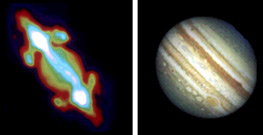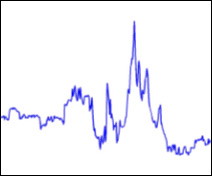Lessons Overview : Radio Sources I
Radio telescopes allow us to study the magnetic fields, or magnetospheres, of planets. The strongest planetary radio source currently known is Jupiter. Jupiter's magnetic field is around 19,500 times stronger than that of the Earth. Charged particles from the Sun and Jupiter's moon, Io, are accelerated in the magnetic field and cause radio emissions. As a result, Jupiter appear very different when viewed in the radio spectrum.Radio stars are another example of objects that are much more interesting in radio astronomy than in optical astronomy. Our Sun's radio activity increases when it emits huge bursts of energy, called flares. There are other stars that also emit flares, some of which are up to a million times more powerful than flares from the Sun.
The space between stars contains invisible clouds of gas and dust which are easily observed in radio. From our radio observations of this interstellar medium we have learned that our universe's most abundant element is hydrogen. We can tell this because hydrogen has a "radio signature" at a wavelength of 21 centimeters. Since hydrogen permeates the universe, radio astronomers can actually use hydrogen to map out the entire structure of our galaxy and others.
Jupiter in radio and optical

Optical: NASA/STScI
Radio: Courtesy of National Radio Astronomy Observatory / Associated Universities, Inc. / National Science Foundation

Optical: NASA/STScI
Radio: Courtesy of National Radio Astronomy Observatory / Associated Universities, Inc. / National Science Foundation
Solar flare observed at Furman University

David Moffett

David Moffett